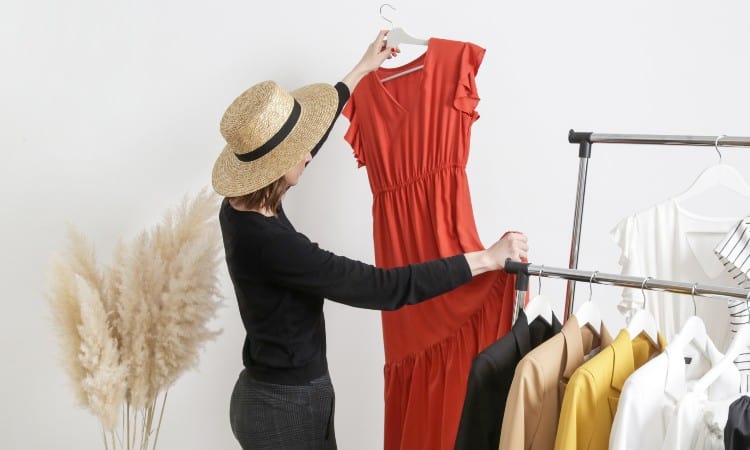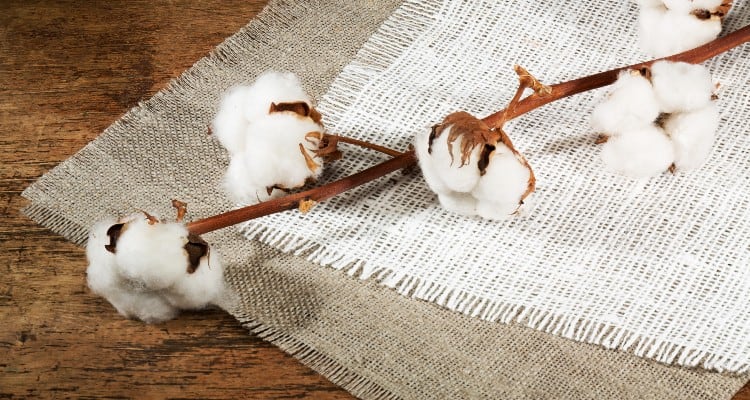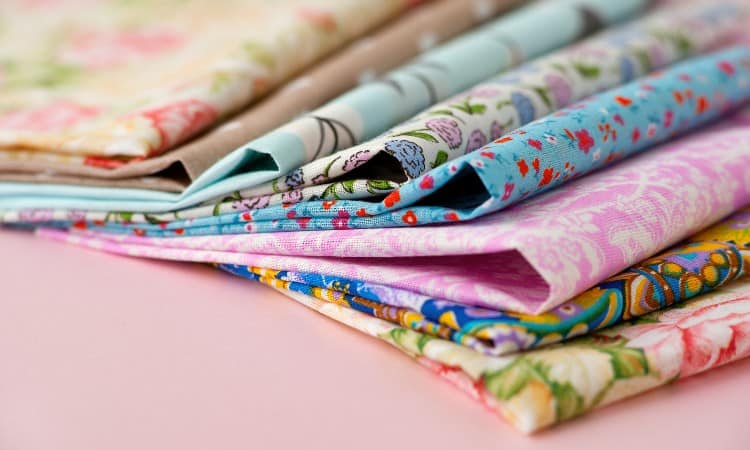Cotton and viscose fabrics can make similar garments. With little between them when it comes to comfort and style, it can be tough to choose between the two. When it comes to cotton vs viscose, what’s the difference?
The main difference between cotton and viscose is the manufacturing process. Cotton comes from the fluffy case of cotton seeds and is a completely natural material. Viscose is a mix of wood pulp and chemicals. Neither natural nor synthetic, it creates an artificial silk fabric. One that looks and feels like the real thing.
In this article, we’ll take a look at the properties of each fabric. Read on to identify the good and bad points of cotton vs viscose. Once you compare them, the difference between the two will become clearer.

Cotton vs Viscose
Although cotton and viscose can be used for the same things, the two fabrics have very different properties. Cotton is a natural fiber that has been a popular staple for generations for all kinds of garments.
Its breathability and moisture-wicking characteristics ensure it remains a firm favorite, especially in warmer climates.
Viscose, on the other hand, is semi-synthetic. It has some of the good points of cotton coupled with the pros and cons of synthetic fibers. Let’s take a look at some of the main differences in a comparison table.
| Cotton | Viscose | |
|---|---|---|
| Breathability | Excellent | Excellent |
| Care | Machine washable Tendency to shrink Wrinkles easily | Dry-clean only or a delicate hand wash Easily damaged by water |
| Durability | Strong and durable gets stronger when wet | Suffers a loss in durability when wet |
| Hypoallergenic | Yes | No |
| Sustainability | 100% cotton is biodegradable The manufacturing process takes a lot of water | Biodegradable The manufacturing process uses toxic chemicals and lots of water |
| Texture | Soft against the skin | Looks like silk but feels like cotton. Soft but can feel cold against the skin |
| Type of Fiber | Natural | Semi-synthetic |
What Is Cotton?

Cotton has been the go-to fabric for clothing for generations. Popular in all parts of the globe in several different weights and weaves, cotton has an enduring reputation for being soft, comfortable, and cozy next to the skin.
It’s also a durable fabric. The heavier-weight cotton, like denim, are known for their resilience. They make excellent working clothes. Lighter-weight fabrics such as gingham are the perfect choice for summer dresses.
Natural, hypoallergenic and incredibly breathable, 100% cotton fabrics are still the top choices for versatile and comfortable clothing to suit any occasion.
| Pros | Cons |
|
|
Types of Cotton
There are three different types of fiber for cotton. Long-staple fibers are used to make high-quality, top-of-the-range products. Medium-staple fibers are found in mid-quality items and casual everyday clothing. Short-staple fibers are the ones found in carpets. These are lower quality fibers than the other two options.
Cotton can also be blended with other fabrics. The most popular blend is polyester creating a polycotton. This mix is great in utility clothing, such as scrubs, due to being easy to care for and ready to wear straight from the dryer.
Spandex or lycra can also be added to cotton to give a comfortable, slightly stretchy fit to clothing. Cotton can be quite a rigid fabric; the extra give provided by a little bit of lycra can help create looser, more comfortable garments.
What Is Viscose?

Viscose is a hybrid of natural wood pulp mixed with chemicals to create a semi-synthetic fabric. With a similar drape and feel to silk, viscose is the cheaper but just as luxurious alternative.
It’s very similar to rayon, another semi-synthetic fabric made to imitate silk. Unlike rayon which looks and feels like silk, viscose may look like silk, but it feels like cotton. The versatile appearance of the fabric is one of the reasons for its popularity.
Introduced in 1883, viscose is relatively inexpensive to produce and can make dresses, jackets, carpets, and upholstery. It’s a fabric that is easy to dye and resistant to fading.
This fabric is breathable and absorbent, making it a great choice for sportswear. It can be blended with other fibers, including cotton, polyester, and stretch fabrics like spandex.
| Pros | Cons |
|
|
Types of Viscose
Viscose is a member of the rayon family of fabrics. Viscose is sometimes referred to as rayon or rayon viscose.
There are three different types of rayon fabrics. Known as a model, viscose, and lyocell, each one originates from the cellulose extracted from wood pulp. They are processed slightly differently to produce characteristics unique to each type.
Model and viscose fibers are formed in much the same way. However, the model fibers are stretched after spinning. This means model fibers are longer, finer, and lighter than viscose.
Lyocell’s production uses an organic, non-toxic substance making it more ecological. The compound can be reused, making lyocell the most sustainable member of the rayon family.
How Is Cotton Made?
Cotton is made from the soft, fluffy protective casing surrounding the cotton seeds. This is known as the boll. The cotton plant needs sun, decent rainfall, and limited exposure to frost to grow. This is why the best locations are tropical or subtropical.
Production of cotton is an in-depth procedure. First, the cotton is collected in two ways. Either the whole plant is harvested, or the boll is stripped from the plant. After harvesting, the cotton is turned into bales and left to dry in the fields.
A machine known as a cotton gin is used to clean and fluff the cotton fiber from the rest of the plant. The resulting fibers are then pressed together before being sent to fabric mills.
At the mills, the fibers are carded to clean them and form short strands. These short fibers become a long strand, which is now ready for spinning into yarn. The yarn is then woven into different weight cotton fabrics.
How Is Viscose Made?
The process of making viscose is more involved than cotton. Viscose is derived from the wood pulp of plants like bamboo. When dissolved in chemicals, the wood pulp forms an alkali solution.
This alkali solution is pressed to remove liquid. In a similar way to how paper is made, the pressed matter is formed into sheets. The next stage involves chopping the sheets into tiny pieces known as crumbs.
More chemicals are added and the crumbs are dissolved into a solution of sulphuric acid. Creating a viscose solution. Filtering the solution removes any remaining traces of acid.
Next, trapped air is removed from the mixture as any air bubbles could cause weak spots in the final product. The solution is pushed through a machine known as a spinneret to form filaments or long fibers of regenerated cellulose. It’s the regenerated cellulose that is then spun into yarns and woven into fabric.
Which Is Better: Cotton or Viscose?

When it comes to a choice between cotton and viscose, it can be difficult to tell which one will suit a project better. Let’s take a look at some of the characteristics of both fabrics to compare the benefits and disadvantages.
Breathability
Both viscose and cotton score highly when it comes to breathability. As they are both made from plant material, albeit from different parts of the plant, they have the inherent benefits of all natural fiber-based fabrics.
Cotton has a slight edge, though. It can absorb moisture, taking it away from the skin and keeping you cooler. The wetness of the fabric can also be refreshing in warmer climates.
Viscose, on the other hand, keeps you cool by draping away from the body. So rather than absorb moisture, it gives it room to evaporate. If it gets wet, the breathability of the fabric is reduced. You could end up feeling warm and sweaty.
Warmth
There are several different weaves and knit fabric options when it comes to cotton. All the variations are good for insulation against the cold and for allowing heat to escape.
The heavier weaves like denim, corduroy, and flannel can be used to keep you warm in cooler temperatures. Lighter-weight cotton is perfect for hot summer days. Cotton can even be layered to give extra warmth on cooler days.
Viscose may be imitation silk, but it feels a lot like cotton. A lightweight fabric, viscose is ideal for summer apparel. There is a lot of debate whether it’s a fabric that can keep you warm or not.
Similarly to cotton, viscose garments can also be layered. Up to a point. The natural drape in the fabric creates gaps between clothing and skin, making you feel cold.
Viscose, like polyester, is best worn on top of something like cotton to give better insulation. The synthetic nature of viscose may mean you could overheat, so be careful how you layer it.
Softness
 Some kinds of cotton can be rough or rigid when you first purchase the garment. The stiffness washes out over time to create a soft piece of clothing with a lived-in, well-loved look.
Some kinds of cotton can be rough or rigid when you first purchase the garment. The stiffness washes out over time to create a soft piece of clothing with a lived-in, well-loved look.
Other pieces of cotton are soft from the start. Take flannel, for instance, a lovely, cozy fabric that makes super-comfy pajamas. Softness is one of cotton’s endearing strengths.
Viscose starts soft, smooth and silky. It has an expensive-looking opulence and feels like soft cotton. What lets viscose down is the tendency to pill. Rather than get softer over time, it loses strength when wet. Both downsides can affect the softness of the material.
Thickness
As a lightweight fabric, viscose isn’t particularly thick. Although it does have the feel of cotton, it’s imitation silk, so it’s finer. It’s a fabric known for light and airy summer dresses, blouses, and shirts. The lightness of the fabric is what gives it drape.
Cotton can come in different weights. From the ultra-thin cotton voile to a super-thick canvas. Each different weave can have a different thread count per inch. Known as denier, the higher the number, the thicker the fabric.
Moisture-Wicking
 Neither cotton nor viscose wicks moisture. They both absorb it. This can be a good thing and a bit of a disadvantage.
Neither cotton nor viscose wicks moisture. They both absorb it. This can be a good thing and a bit of a disadvantage.
Viscose can lose structure when it gets wet. The fibers are easily damaged by water. In warmer weather, your viscose shirt absorbing moisture from your skin could lead to it becoming uncomfortable and stiff. It can also shrink.
Cotton is like a sponge. It sucks up body moisture and holds on to it. The fabric can take a long time to dry. Leaving you feeling cold if the weather is a little chilly. On a good note, if the weather is warm, the added moisture in your shirt can help you stay cool.
Colors
Viscose is easy to dye and holds on to color well. It is resistant to fading even after frequent washes. You can dye viscose with reactive dyes in the same way you can with cotton fabrics.
Cotton is also easy to dye. Unfortunately, unlike viscose, the color will fade over time, which doesn’t necessarily have to be a bad thing. The fading can create an on-trend fashion effect, known as the distressed or well-worn look.
Shrinking
Another area where both cotton and viscose behave in the same way is shrinkage. They both shrink. Cotton tends to shrink the most on the first wash, which is why many manufacturers will pre-wash the fabric before making garments with it.
Normally, synthetic fabrics don’t shrink but, as viscose is cellulose-based, it’s only part-synthetic. When it comes to shrinking, viscose embraces its natural side. Unfortunately, unlike cotton, viscose will shrink with every wash. This is why this fabric tends to be dry-cleaned only.
Cost
On the whole, cotton tends to be more expensive than viscose. Both the processing and harvesting of cotton can be pricey. The need for pesticides or effects of a bad year weather-wise can increase costs leading to extra expense.
Viscose, on the other hand, is relatively cheap to produce and is not as reliant on good weather for a perfect harvest. It’s not as versatile as cotton, though and has limited uses in comparison. Neither is it as popular, meaning it could be hard to find.
Sometimes, cheap isn’t always a benefit though. For the sheer volume of projects, tasks, and uses you can put a cotton fabric too, its adaptability more than makes up for the cost.
Ease of Care
Of the two fabrics, viscose is harder to care for. It can be damaged by water making it unsuitable for garments that need regular washing. Prone to shrinking with every wash, the fabric is best suited to dry cleaning.
Not only that, viscose doesn’t like heat. Too much sun will cause deterioration. Because of this, and its hatred of water, spot cleaning is recommended when you can’t get to the cleaners. The only trouble is, its sensitivity to being cleaned with even the slightest amount of water can make stains difficult to remove.
Cotton is a breeze to care for in comparison. You can machine wash it, you can tumble dry it, and you can line dry it in sunlight. Although it can shrink when washed for the first time, regular washing can improve the cotton fabric. It gets softer and less stiff with every wash.
Uses
 Viscose and cotton can be used for the same projects. With the same look as silk, viscose can be used to create floaty summer dresses with excellent drape. Unfortunately, as it’s imitation silk, it isn’t a durable fabric. Although it can be made into activewear, it’s not suitable for clothing used for working on a building site.
Viscose and cotton can be used for the same projects. With the same look as silk, viscose can be used to create floaty summer dresses with excellent drape. Unfortunately, as it’s imitation silk, it isn’t a durable fabric. Although it can be made into activewear, it’s not suitable for clothing used for working on a building site.
It makes beautiful window treatments. The natural drape of viscose fabric is ideal for full-flowing curtains. Just like silk, viscose can be used for comfortable, cooling bedsheets and will add a touch of affordable luxury to your bedroom.
Cotton is a versatile fabric used for generations for clothing, bedding, window dressings, and much more. From baby clothes to upholstery, cotton is still the top choice for a multitude of projects.
Coming in a range of different weaves, knits, and weights, you’re sure to find a cotton fabric to suit your needs. Stronger, softer, and a lot easier to care for than viscose, cotton is hard to beat.
Should You Choose Cotton or Viscose?
Both viscose and cotton have their benefits and disadvantages. Viscose is easier to dye and resistant to fading. Your colors will stay bright and last the lifetime of the garment. The drape of the fabric is light and flowy. Viscose is a luxury fabric at an affordable price.
It can be tricky to care for though. Frequent washes are not good for the fabric. Constant trips to the dry-cleaners may not be good for your wallet.
Cotton is hypoallergenic and a tonic for sensitive skin. Depending on the denier and weave, the fabric has the power to keep you warm or cool. It’s easy to care for and even easier to wear. A ubiquitous fabric that can be both durable and baby-soft to the touch.
The choice between cotton vs viscose can be a challenge. Whichever fabric you choose is down to personal preference, your finances, and the overall effect you are looking for.
Conclusion
With viscose and cotton being so similar, it can be a tough task to pick one over the other. Now you know the differences and the strengths of each fabric, your choice should be a lot easier.
Let me know in the comments if you liked this article. Has it helped you decide between cotton vs viscose for your next project?